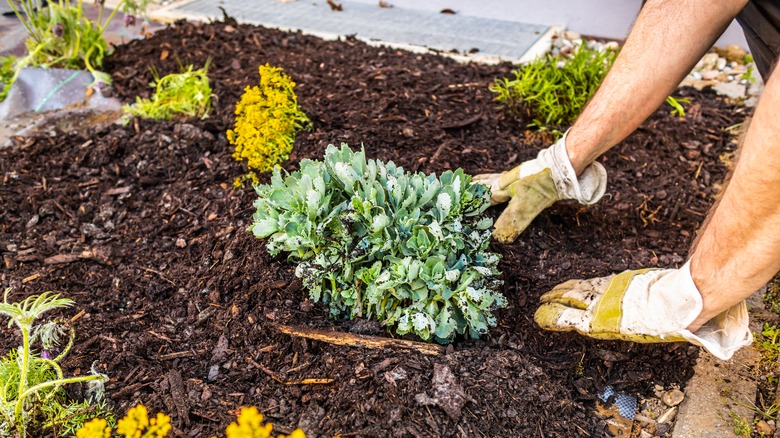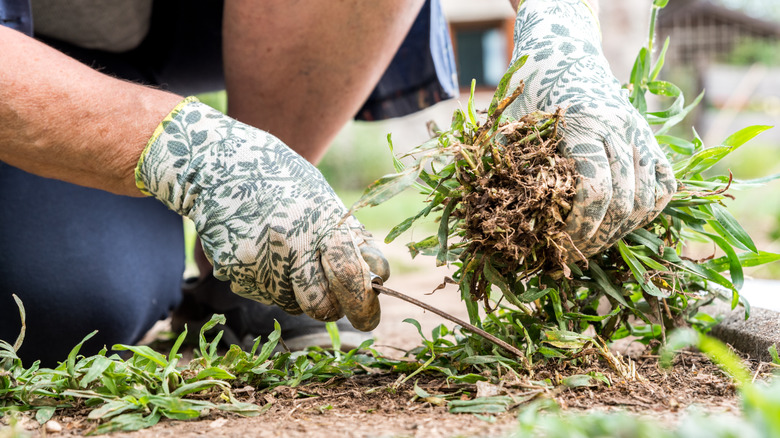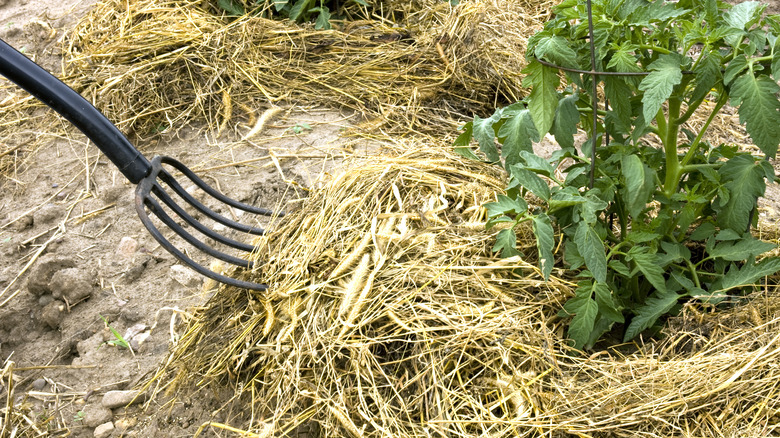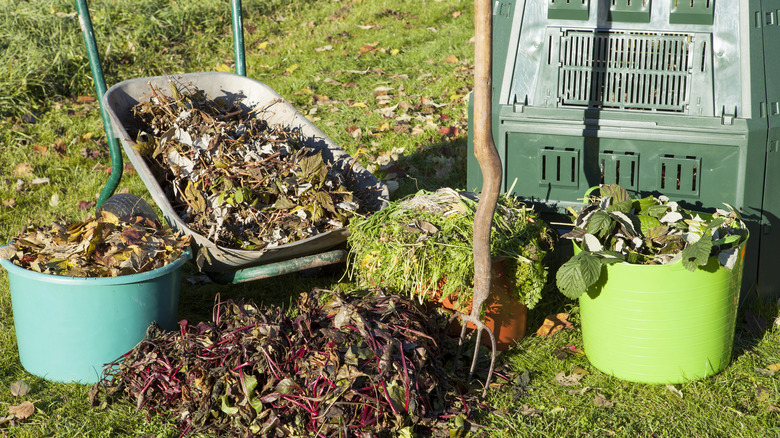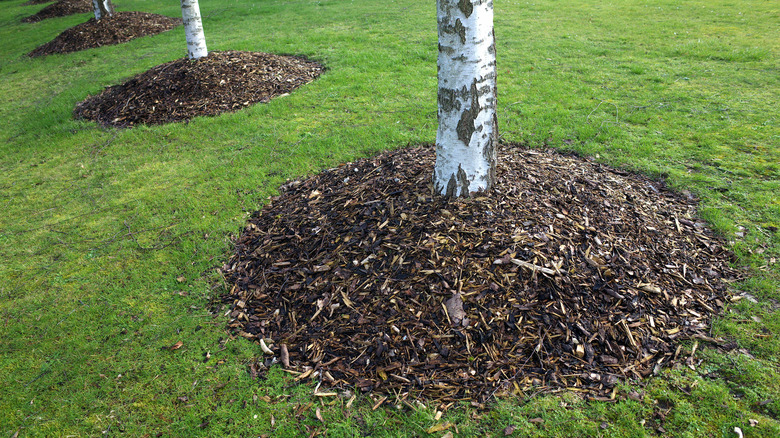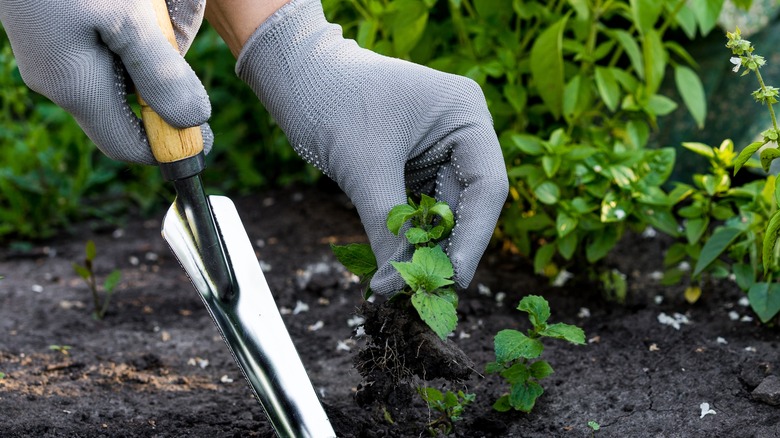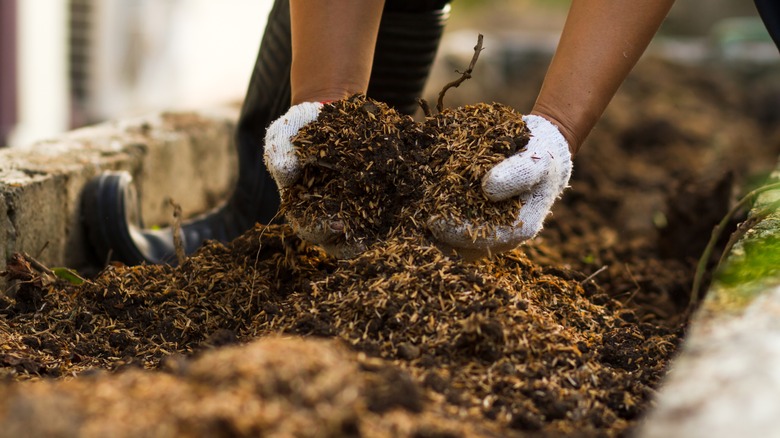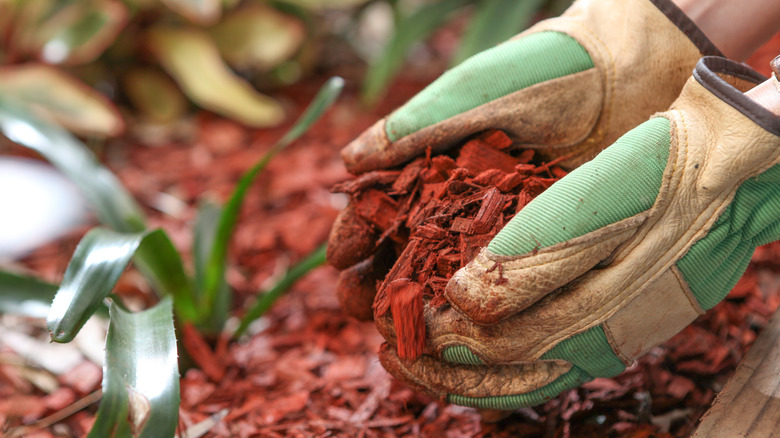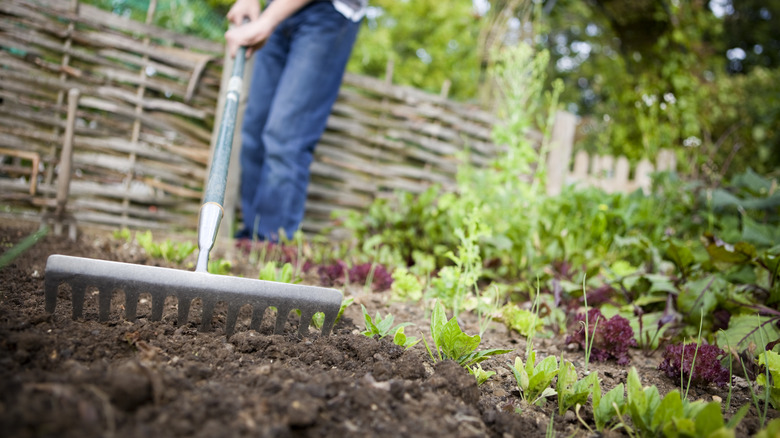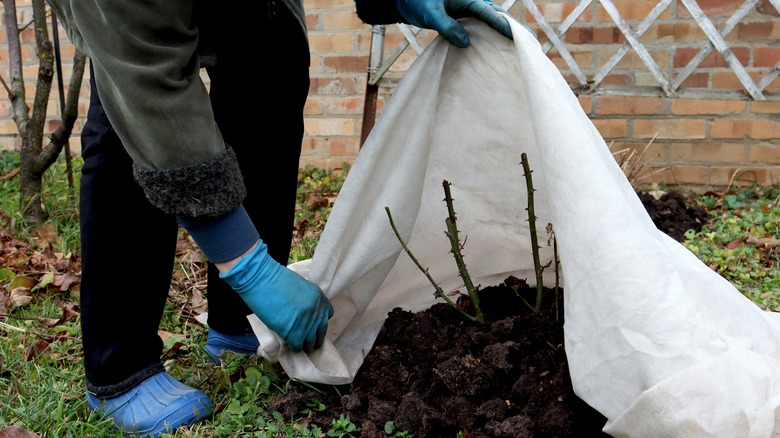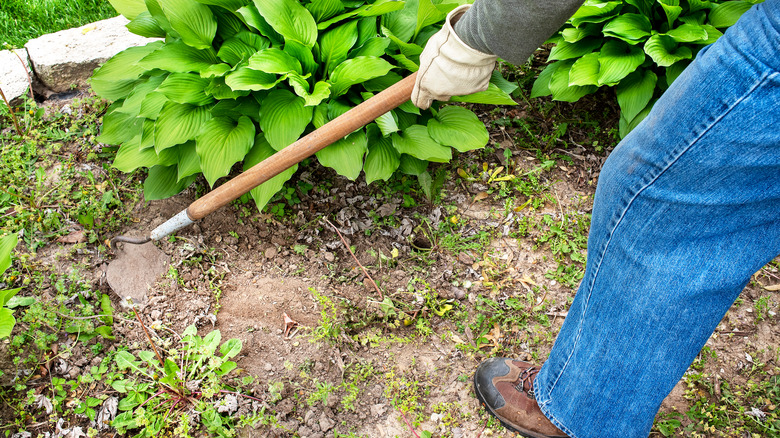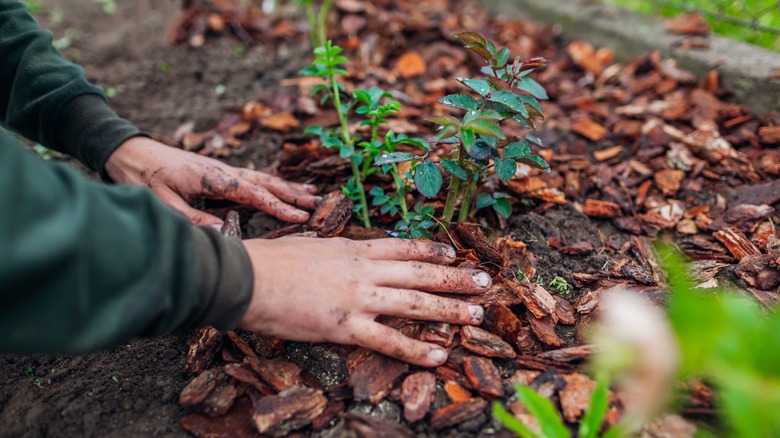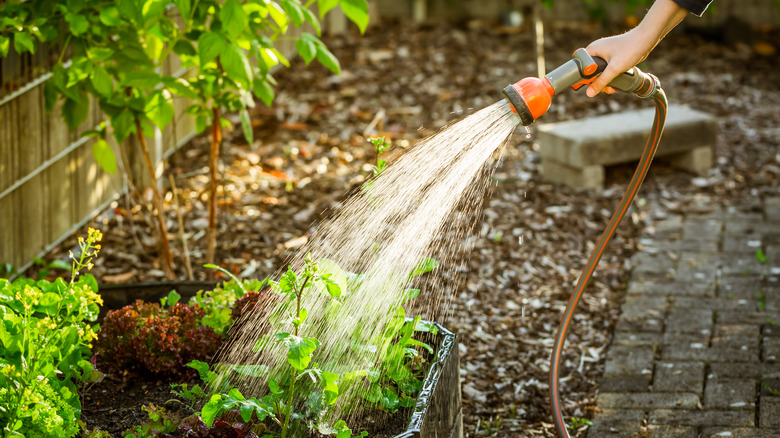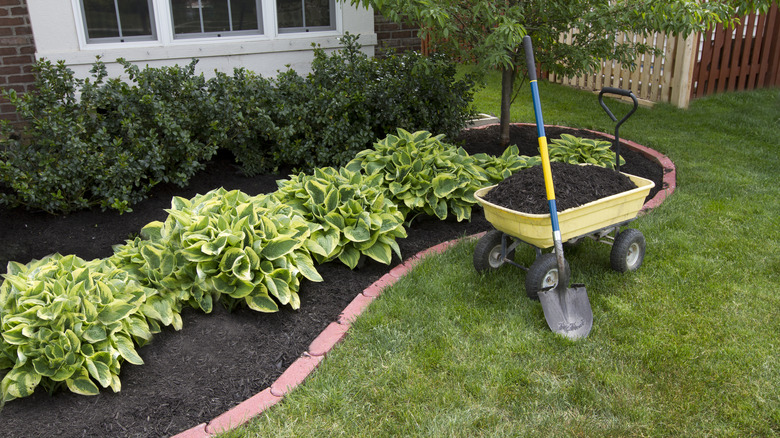13 Mulch Mistakes That Are Ruining Your Garden
Whether you've just begun your gardening journey or have been growing one for years, you've likely been in the habit of spreading mulch over your vegetable and flower beds. Many gardeners swear by this practice because it does the soil and plants immeasurable good. But are you mulching your garden the right way?
Nothing is perfect under the sun. As such, there are many mistakes you can make when mulching your garden. All of those myriad mulching benefits will be for naught if you aren't able to do things correctly. Whether you've laid the mulch on too thickly, not watered it thoroughly enough, or are using the wrong kind with the wrong plants, mulching mistakes can bring disease, excessive water, fungi, pests, and weeds to your garden.
We've assembled this list of mulching mistakes to give you an idea of their potential damage. The good news is, however, that all of these mistakes can be remedied. Some will be fixed more quickly than others, but that doesn't mean you should get in the habit of making them. At the end of the day, you can fix every one of these 13 mulching mistakes that are ruining your garden.
Not using mulch at all
Here's some irony for you: failing to mulch your garden at all is the biggest mulching mistake you can make. Mulch does wonders for a garden. It retains moisture, acts as a pH balancer, temperature moderator, and is a block against erosion. The water retention is especially good if you live in more arid areas or happen to be going through a dry season. Also, as most mulch is made out of organic matter, it will break down into compost and benefit your soil even further.
Mulch is also a fantastic barrier against weeds. No one likes to weed their garden. It's time-consuming, and if you don't keep on top of it, the weeds could very easily take over your entire space. Mulch presents an easy solution. It can smother weeds and keep them down. Weeds like the same kind of soil that plants do: soft and loamy. It's easy to push through. By mulching over the weeds, you create a barrier that keeps them from reaching the sun above. Then they will just die and return back to the earth.
Let's recap. In mulch, you've got water retention, weed abatement, erosion blocker, pH balancer, and temperature moderator. All in all, that afternoon spent mulching is going to yield a far healthier, less stressful garden.
Using too much mulch
You certainly don't want to skimp on the mulch, but using too much will not do you any favors. In fact, using too much mulch is almost worse than using no mulch at all. Here's why.
Your plants need oxygen in order to survive. If they are deprived of it, they will die. If you're layering the mulch on too thick, the plant roots are not going to be getting the oxygen they need. This occurs because the thicker layers of mulch are doing their job incredibly well. That is, they are holding onto water. As a result, they become swollen and saturated, and the roots eventually suffocate. Then, there's the fungi.
As can happen with compost, excessive moisture in mulch creates the perfect habitat for fungi. There are certain funguses that can wreak havoc on your plants, causing stunted growth and, in some cases, even death. The solution, then, is to create a mulch layer that is no more than three inches thick. Between one and two inches is the preferred layering depth, but you may need more depending on the plant. However, anything more than three inches will result in this poor environment that will certainly end up harming your plants.
Using the wrong kind of mulch
Mulching is not going to make any kind of beneficial difference if you're not using the right kind. There is a big difference between the mulches that are meant solely for landscaping and those that serve a functional purpose in the garden. Using gravel or stones in the tomato bed is just as useless as using straw in the rock garden. There is a mulch for every type of project, and it is incumbent upon you, the gardener, to know which one is going to work best for your plants.
Shredded leaves, compost, decomposing hay, straw, newspaper, and cardboard are all examples of organic mulches that will serve well in your garden beds. You tend to want to avoid chunkier mulches or even finer ones like sawdust, as they can have an adverse effect on your soil's pH level and make maintenance between the rows a little tricker. However, if you've got blueberries, which thrive in acidic soil, the thicker the mulch, the better. Chunky wood chips and pine needles are tremendous options for this fruit.
Choosing the right kind of mulch is one key to your garden's eventual success. Do your research and see what works for all your plants, from your annuals to your long-lasting perennials. Once you've found what works, stick with it.
Volcano mulching
This is a mulching mistake that applies exclusively to trees. The trees in your yard or orchard should not become the unwilling victims of a mulch avalanche. The problem in question is what's called volcano mulching. It is the process by which tall, thick mounds of mulch are piled up around the base of trees. If you do this enough times, you're not going to have a tree much longer.
As a remedy, look to forests as an example. The falling leaves and pine needles create fresh mulch for the forest floor every year. Have you ever seen that mulch piling to the point where it's climbing a third of the tree? No, you haven't. When trees are volcano mulched, the mound covers the trunk, which was never designed to be under cover.
Thinner rings of mulch are going to serve you best here as they feed the tree roots, which are supposed to be under cover. Mulching so high enough to meet the trunk is just going to invite disease and provide a haven for insects and other pests. The thicker mulch will also deprive the roots of oxygen and create fungal infections that can kill the tree. It's better to form a large ring that extends past the tree's drip line so the mulch can catch water, and don't layer it on more than three inches.
Not removing weeds
While weeds are not going to be much of an issue if you mulch your garden properly, you still won't be free of them outright. Something that can actually occur is that the mulch will end up encouraging more weed growth as a result of the soil being healthier. It's a paradoxical problem, to say the very least, but there is an easy way to get around this.
When you're plotting out a new garden space, you don't need to spend ages removing the grass and tilling the earth in order to kill any weeds that might be there. Instead, put down a layer of cardboard, newspaper, or compostable leaf or animal feed bags. These create a barrier between the grass and the garden that is being placed on top of it. The barrier smothers the grass and the weeds beneath, providing you with a fresh patch in which to put plants.
However, once your beds are decently established, you should do a once over at the start of the season to see if any weeds are beginning to grow already. If there are, pluck them immediately. Don't mulch over them right away. The bigger, stronger weeds are going to be able to push through. Be sure to keep on top of things. The less weeds you have to deal with as a gardener, the happier you will be.
Mixing mulch into soil
While your mulch will, over time, decompose to become one with your garden soil, mixing them together when both are fresh is a big mistake. Remember, mulch is meant to act as a protective layer over the soil. By mixing it in, you are negating this primary function of the mulch and are also potentially doing some damage to your plants as well.
You see, the mulch and the soil are not the same in terms of nutrients. When you mix mulch directly into the soil, you are actually creating a nutrient deficiency, which could end up affecting plant growth. This is true with the chunkier organic mulches, and is especially true with those types of mulches that are manufactured. This mixture make things especially tricky when it comes to weeding, which is already aggravating enough.
However, this rule does not apply to compost. Mixing in compost with your layer of topsoil is actually going to be beneficial to your garden, because it is already mixing broken down nutrients into the soil. This, in turn, is going to help keep the plants fed when you eventually add a mulch layer on top.
Using dyed mulch
Unless you're making your own mulch from natural resources on your property or purchasing it from a trusted organic source, you're most likely going to be buying your mulch from your local hardware store or garden center. This is not necessarily a bad thing, but you need to be careful. Understand that when it comes to mass produced mulch, there is a high likelihood that chemicals have been involved in the manufacturing. And you especially want to watch out for mulch that is dyed.
Dyed mulch can be toxic for any garden or landscape. Most dyed mulches are made from recycled, treated lumber that is already laced with a number of different chemicals and additives, including arsenic. Add to that the chemicals in the dyes themselves and you have yourself a recipe for garden disaster.
Not only do these chemicals ward off necessary nitrogen development, but they can kill the numerous beneficial bacteria that exist inside of your soil. The dye will also run off the mulch during a good rain, causing it to leach into the rest of your yard. So, always ask if the mulch you are purchasing is dyed, or be sure to read the label on the bags. You don't want this stuff anywhere near your garden.
Not performing maintenance
Putting down your layer of mulch is not a one-and-done thing. It needs to be maintained over the course of the year in order to make sure that everything is still the way it should be. While you can control when and how thickly you lay down your mulch, you cannot control things like storms, animals, or other natural factors that can come in and mess up your mulch layer.
You should get in the habit of checking your garden mulch at least once a week, if not daily. It depends on how serious you are about growing food and making sure that the mulch is doing its fair share of the work. You won't always have to work on the mulch, but it's good to keep an eye on things. A metal rake is all you need for mulch maintenance. A few times per season, go over your garden and see where the mulch is uneven or where there are bare spots. Use the rake to turn over and smooth the mulch into one even layer, filling in the gaps as you go along.
It's also good to see where in your garden mulch decomposition is happening. Wherever this is occurring, you can rake it into the soil and cover it with fresh stuff. You can make this part of your seasonal gardening routine. The more you are on top of the maintenance, the less you are actually going to have to do in the long run.
Mulching too early
One of the most common gardening mistakes beginners make is not marking the first and last frost dates on your calendar. If you plant before your last frost date in the spring, your seedlings may very well end up dying in a cold snap. By the same token, you don't want to be mulching your garden too early. While the mulch will help maintain temperatures later on in the season, too early an application may end up actually doing more damage.
Here's what we mean: one of the reasons we plant in the summer, spring, and early fall is because the soil has had sufficient time under the sun to thaw and warm up to the point where new growth can be fostered. If you put a blanket of mulch over that soil before it has had the opportunity to warm up properly, it might not reach the temperatures it needs to by the time it needs to reach them.
It is best to wait until middle or late spring to put mulch down in the garden. The soil beneath will have had sufficient time to warm up, and the mulch will now work to maintain that optimal temperature throughout the growing season. It's also a good idea to mulch over frost-sensitive plants to keep them from freezing during the winter.
Using old mulch
This mistake depends on the decomposition level of your mulch. Mulch typically takes one to three years to decompose completely but may do so faster in the presence of severe weather like snow and rain. At the decomposition stage, the application of new mulch will only continue to help the old mulch be reclaimed by the earth, and thereby feed the plants.
However, if you used fresh mulch in the fall to protect the susceptible plants, you are going to want to remove that before you've placed down your new layer. This is because you want that soil beneath to be exposed to the sun for a period so it has a chance to warm up. Also, there is a possibility that there is frost clinging to the mulch itself. You don't want to carry that over into your garden because it will affect the temperatures in the soil below.
Also, if you haven't mulched a bed in a while and the area has grown up with weeds, you want to remove that layer of old, weedy mulch before you put any new stuff down. This way, you aren't just covering up well-established weeds, most of which are likely strong enough to break through this new layer of mulch.
Mulching everything
While it is true that mulching is enormously beneficial for your garden, it doesn't necessarily mean that you should be mulching everything in sight. You don't need mulch in order to have a successful garden. In fact, if your soil is rich enough, it may not even require it. Your local municipality might also have certain mulching recommendations or rules that need to be followed, so it would be worth your while to check those out before you come to any final decisions.
Plus, there is a chance that the mulch will prevent beneficial garden insects from taking hold. Think of the various types of bees and other pollinators that populate the garden. They may nest in the ground. Bare or very lightly mulched soil is going to be easier for them to burrow into.
Also, as mentioned earlier, not all plants and areas of your yard are going to require the same kind of mulch. Do your research as to what types of mulch are going to work best for your yard. Then, implement accordingly.
Not watering properly
Watering the garden or lawn is more time-sensitive than one might think. Overwatering is certainly an issue, one that can yield bad results. When it comes to mulch, however, you'll want to water your garden less frequently than you think you might need to but for longer periods of time. Remember, the mulch is creating a barrier between the outer elements of the garden and the roots beneath. Therefore, you need to water accordingly.
Water needs to penetrate through the mulch in order to get to the roots below. Nothing short of a deep watering is going to get this done. Shallow watering is ineffective because it will not reach the roots and most likely evaporate when the sun hits it.
You should be watering your garden for at least 30 minutes before the sun comes up in the morning. This way, the water had a chance to reach its optimal depth, which is about 8 inches, and for the sun to have evaporated the water on top of the mulch. Do this at least twice a week. It will actually end up saving you time and money.
Neglecting mulches scenic value
While our main discussion has been on the benefits mulch has below the surface of your garden, let's not forget that mulch also adds a lot of scenic value to your yard. Well-mulched gardens and landscaped areas look clean and tidy and will greatly enhance your home's visual appeal. This is not only beneficial for your eyes but also for the eyes of potential buyers who see value in the exterior of your home.
Therefore, while your primary focus should be on the types of mulches that are going to serve your plants best, don't overlook looks. Choose mulches that also look really good when they are put down on the ground. You can get really creative with color and texture schemes to make a really dynamic and visually appealing yard. Rocks along the border of your house matched with a beautifully mulched perennial bed is one of a number of different examples. Experiment, and have fun.
This list is not comprehensive, but the hope is that it has given you knowledge as to what kinds of mulching mistakes are ruining your garden. Most, as you've seen, are easy to fix when made. However, the best fix is not to have made the mistakes in the first place.
